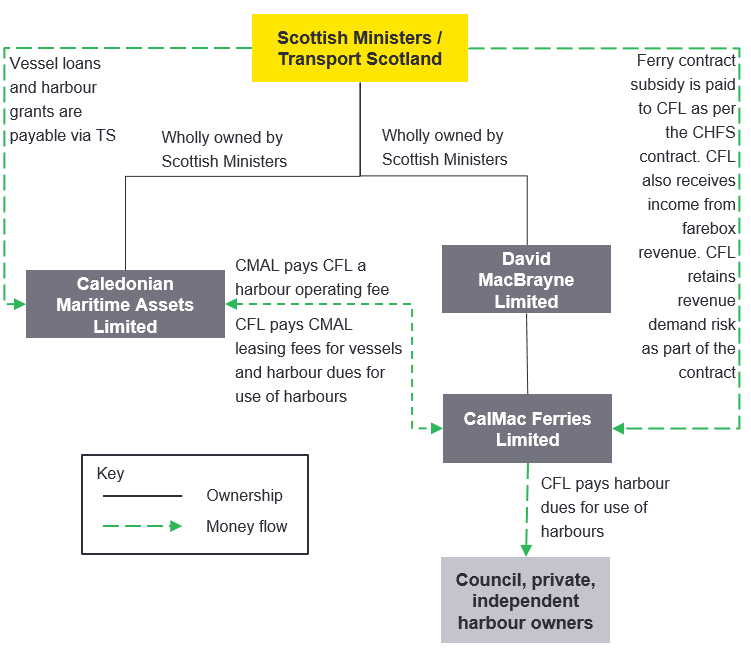An introduction to Project Neptune
TS seeks to deliver a safe, efficient, cost-effective and sustainable transport system for the benefit of the people of Scotland, thereby playing a key role in helping to achieve the SG’s purpose of sustainable economic growth with opportunities for all of Scotland to flourish.
Ferry services in Scotland fulfil a critical function within the wider transport system, providing lifeline services to island communities.
Ferry services on the CHFS network are subsidised by Scottish Ministers and delivered primarily by three parties: TS, CMAL and CFL as a wholly owned subsidiary of DML (together “the Tripartite”).
The delivery and cost of ferry services and the relationships between the Tripartite are complex, and Scottish Ministers are mindful of the perception which exists of a lack of accountability among the parties.
Purpose
The objective of this review is to provide Ministers with a strategic framework of options for the CHFS network.
- Our review’s purpose is to help to identify the preferred corporate and governance structures for the delivery of ferry services on Scottish Ministers’ behalf.
- The strategic framework of options provides Ministers with our views on what could be done to restructure the CHFS network, rather than on what should be done.
- Any structure proposed for delivering ferry services on behalf of the Scottish Ministers should enhance passenger experience, support local communities and be accountable, transparent and capable of achieving Best Value.
The diagram below includes an overview of the current structure of the CHFS network.

The CHFS network is primarily delivered by three parties: TS, which acts on behalf of Scottish Ministers and is responsible for setting policy and procuring lifeline services; CMAL, which is the asset owner of 36 vessels and 26 harbours (used across both the CHFS and the Northern Isles Ferry Services (NIFS) networks) and; and CFL, which is the operator and is responsible for the delivery of services under the CHFS2 contract.
Policy Considerations
The current policy objectives for Scotland’s lifeline ferry services are set out in the following key documents:
- The Scottish Ferries Plan (2013-2022) provides a basis for the shape of all of Scotland’s ferry services until 2022 (and beyond as vessels have a 30 year design life)
- The Vessel Replacement and Deployment Plan is intended to complement the Ferries Plan by considering historical and projected customer demand and the ongoing provision of capacity to meet that demand
The latest Scottish Ferries Plan is currently being developed by Ministers and is expected to be published in December 2022. It is likely that the plan will include consideration of issues such as Scotland’s low carbon agenda and how ferry services can help achieve these ambitions.
When considering the options put forward in this report, the following questions will be key:
- What are SG’s main policy objectives that are relevant to the ferries sector?
- How could the structure of the Tripartite best help to achieve these?
Report Structure
In order to inform the options developed we have undertaken an international benchmarking exercise of lifeline ferry services and a review of comparable subsidised industries in Scotland and across the UK. The options considered draw on the findings from each of these exercises and have been evaluated using an agreed set of criteria. This section of the report is split into the following parts:
Benchmarking
The purpose of the benchmarking exercise is to develop an understanding of the different models adopted by both ferry operators internationally and similar sectors in the UK.
The information gathered as part of this exercise will enable the identification of key points of difference between markets and highlight potential ‘lessons learned’ that could be applied in the context of Scotland
Options for consideration
It is evident from our benchmarking and sector analysis that there are a number of alternative models Ministers could adopt in delivering ferry services on the CHFS network. We have reviewed commercial contractual considerations, options for increased regulation and options for structural reform.
Preliminary Evaluation
The evaluation criteria reflects Scottish Ministers’ priority that any structure for delivering ferry services in Scotland should enhance passenger experience, support local communities, be accountable and transparent, as well as capable of achieving Best Value. Deliverability has been added in recognition of the practical limitations that could preclude any given option’s viability.
< Previous | Contents | Next >